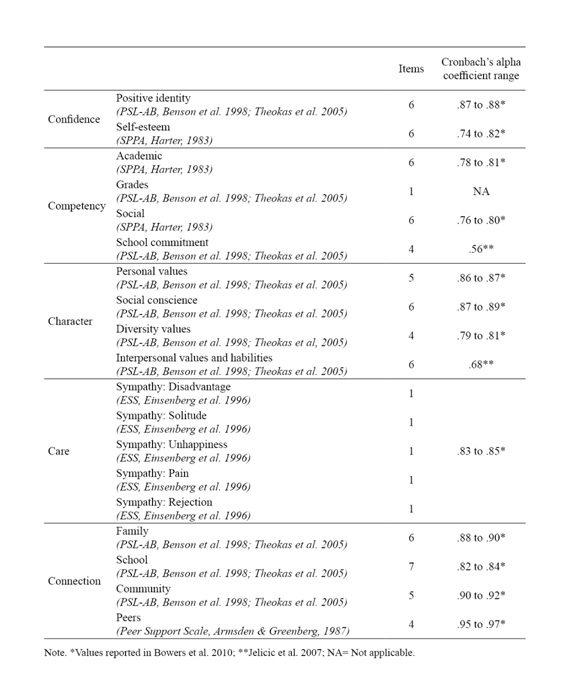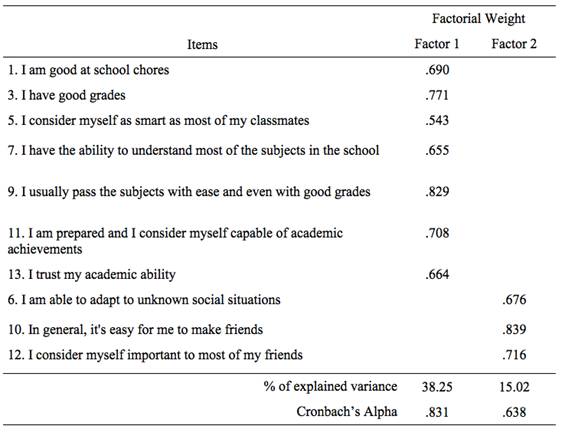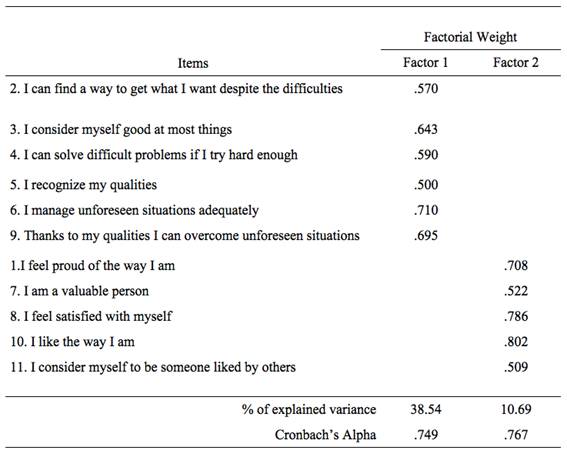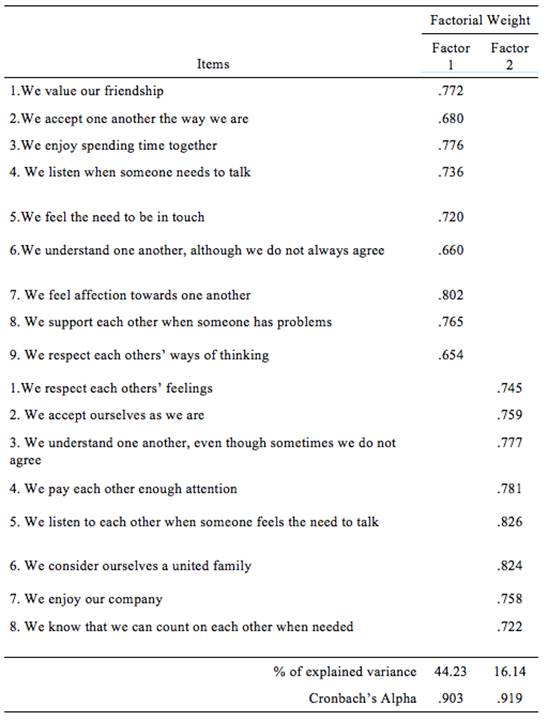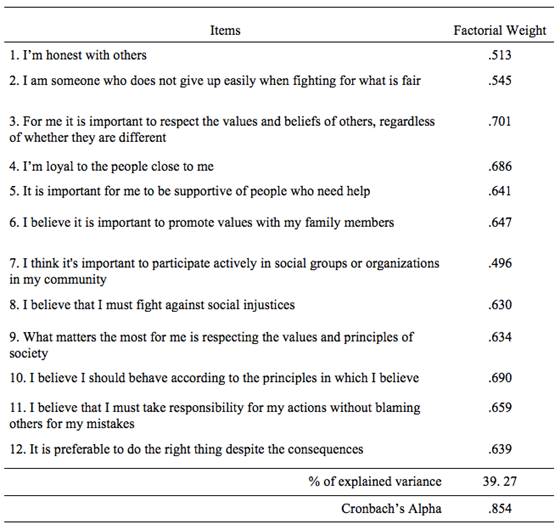Services on Demand
Journal
Article
Related links
Share
Ciencias Psicológicas
Print version ISSN 1688-4094On-line version ISSN 1688-4221
Cienc. Psicol. vol.12 no.2 Montevideo Nov. 2018
https://doi.org/10.22235/cp.v12i2.1690
Original Articles
Assessment of positive development in Mexican adolescents: Exploratory study
1Facultad de Psicología, Universidad Anáhuac. México diana.betancourt@anahuac.mx, alejandro.gonzalezg@anahuac.mx,mariajose_acedo1@hotmail.com, eliagem@hotmail.com, clau.greeneto@hotmail.com,samorenstein@hotmail.com Correspondence: Dra. Diana Betancourt Ocampo. Avenida Universidad Anáhuac No. 46. Lomas Anáhuac, Huixquilucan, Estado de México, México, CP52786.
Keywords: positive development; adolescents; psychological assessment; measurement; scale
Palabras Clave: desarrollo positivo; adolescentes; evaluación psicológica; medición; escala
Introduction
Positive Youth Development (PYD) is a new perspective for the study of adolescence, these traditionally focused on understanding this period of life as a chaotic period where adolescents engage in behaviors that put their health at risk, while PYD seeks to identify particularly important developmental factors to predict favorable physical, emotional and social outcomes (Lerner et al., 2005).
Heck and Subramaniam (2009) conducted a review of the most commonly used models based on PYD: 1) Four Essential Elements of Development, 2) Skills for Life, 3) Assets of Development, 4) Approach to Community Action, 5) Five Characteristics of Positive Development (5 C's). The first four models are proposals that focus on analyzing factors (characteristics, abilities, assets) that could favor healthy development in young people. The last model focuses on analyzing what would be the characteristics that define a young person with a positive development (hence the name of the model); according to the review of these authors, this last proposal is the one with the most empirical evidence.
Lerner (2002; 2004) suggested that the five characteristics that describe an adolescent with healthy development are: Competence (the mastery of certain intellectual, social and behavioral skills); Confidence (positive vision of oneself, with a sense of self-efficacy and self-will); Connection (positive ties with people and institutions); Character (personal and moral integrity assumed by oneself); Care/Compassion (positive human values, empathy and sense of social justice). In addition, within this proposal it is considered that young people who incorporate these five C's would be able to demonstrate a sixth C called Contribution, that is, they could contribute to themselves, their family, their community and civil society; while young people with little of the five C's may be at risk of presenting personal, social and behavioral problems (Heck & Subramaniam, 2009; Lerner, 2004; Lerner et al., 2005).
The study of 4-H is a longitudinal project that served so that Lerner et al. (2005) could design and evaluate instruments that would allow measuring the model of the 5 C's. This study arises from the 4-H, which is a youth organization in the United States that seeks to promote, through various programs, well-being in youth, and which according to Lerner et al. (2005) could be an example of a program from the PYD perspective. In this longitudinal study, measurements were taken from the fifth grade to the tenth grade. In the first measurement, the initial instrument to measure the PYD was designed and evaluated. It registered information from two informants, on the one hand the questionnaire answered by the parents or guardians (PQ, Parent Questionnaire) and on the other, the questionnaire that the students answered (SQ, Student Questionnaire). This last instrument (SQ) included aspects such as the evaluation of: 5 C's, behavioral problems, level of pubertal development, individual and ecological assets, regulation of development, activities and demographic aspects. It should be noted that for the purposes of this research we will focus on the measurement of the 5 C's in the student version.
The instrument by Lerner et al. (2005) that evaluates the 5 C's consists of 76 items, each of the characteristics evaluated have different numbers of indicators (see Table 1). For the development of this instrument, the authors chose a series of instruments that had already been used in other studies and that allowed the assessment of the 5 C's. For example, they used the Profile of Student Life-Attitudes and Behaviors Survey (PSL-AB) developed by Benson, Leffert, Scales and Blyth (1998) and Theokas et al. (2005) to assess the assets (internal and external) of development. Lerner et al. (2005) bases the use of the PSL-AB as they measure indicators of the 5 C's. Something that is worth mentioning is that although most of the indicators used have adequate reliability values (Bowers et al., 2010), this does not apply to school commitment (competence indicator) where, according to Jelicic, Bobek, Phelphs, Lerner and Lerner (2007) this indicator presents an unacceptable coefficient (see Table 1).
Another of the instruments used by Lerner et al. (2004) to evaluate the C's, is Harter's Self-Perception Profile for Adolescents (SPPA) (1983), which was originally designed to evaluate the perception of competence over five specific domains (academic, social and physical competence, physical appearance and appropriate behaviors) and a global assessment of self-esteem in children. Lerner et al. (2005) mention that they made an adaptation of the writing of the items so that they were age appropriate. According to what was reported by Bowers et al. (2010), the reliability indexes reported in the different measurements in regards to the SPPA were adequate (see Table 1).
For the evaluation of care, Lerner et al. (2005) modify five items of the Eisenberg Sympathy Scale (ESS, Einsenberg, Fabes, & Murphy, 1996), which seeks to assess the degree to which adolescents feel pity for the suffering of others; it should be noted that different articles (Bowers et al., 2010; Jelicic et al., 2007; Lerner et al., 2005) report that each of the items used evaluates an indicator of this construct, and thus, not all the articles refer reliability data. The last instrument used by Lerner et al. (2005) is the Peer Support Scale of Armsden and Greenberg (1987), which serves to evaluate the indicator of peers in Connection, and that according to the different measurements, obtains acceptable reliability data.
Since the SQ of Lerner et al. (2005) is an instrument designed for North American adolescent population, Shek and Ma (2010) designed an instrument to evaluate the positive development in Asian population. The Chinese Positive Youth Development Scale (CPYDS) is a scale consisting of 80 items, divided into 15 sub-scales: bonds, resilience, social competence, positive behavior, emotional, cognitive, behavioral and moral competence, self-determination, self-efficacy, positive identity, beliefs of the future, participation and prosocial norms, and spirituality. The authors report that these sub-scales are grouped into four major components: cognitive-behavioral competencies, social attributes, positive identity and general positive development qualities. They also report that the instrument has been shown to be consistent in its structure in different samples of adolescents.
On the other hand, Lopez, Yoder, Brisson, Lechuga-Pena and Jenson (2015) created the Bridge-PYD, which is an instrument that seeks to evaluate the positive development in children and adolescents from the model of the 5 C's, it was formed with 9 items that evaluate the Competence, 10 items that measure the Confidence, 10 items that measure the Connection, 11 items that evaluate the Character dimension and 7 more items that make up the Connection dimension. The findings reported by the authors indicate that Bridge-PYD is a relatively easy instrument to administer and that they also obtained adequate validity indicators. Also, the results showed an adequate adjustment of the model, specifically it was found that the five sub-scales converge to explain a high-order construct that is the PYD.
As can be seen, there are different instruments that have been developed to evaluate the positive development from the model of the 5 C's. However, as mentioned by Gelhof et al. (2015), the instruments must be designed for the context of the population to be evaluated, and up to this moment there are no instruments working from this model in Mexico, which is why the objective of this study was to design and evaluate psychometrically an instrument that evaluates the positive development of Mexican adolescents.
Materials and Methods
Participants
A non-probabilistic sample of 400 adolescents was selected, all students from five secondary schools, four private and one public, from two states: Mexico and Guanajuato. 57% were men and 43% women, with an age range of 11 to 16 years (M = 13.52, SD = 0.89). 15.8% of the participants were in the 7th, 48% in the 8th and 36.3% in the 9th. The only inclusion criterion considered was that the adolescents were students of the institutions where the information was obtained. The consent of the parents was obtained to administer the instruments of the study in the institutional framework.
Instrument
An instrument was designed based on the proposal of Lerner et al. (2004), which consists of 59 items that are grouped into five scales that evaluate the 5 C's: Competency (13 reactive), Care (6 reactive), Confidence (11 reactive), Connection (17 reactive) and Character (12 reagents). All scales were Likert type with five response options, for four of the scales the options were Totally agree to Strongly disagree, only for the Care scale the options were from Never to Always. The development of the instrument was carried out through the review of the literature, specifically for the Competency and Confidence scales, some items of the scales Harter (1983) and Andrade (2013) were used, the other three scales were designed specifically for this study. Once the instrument was prepared, content was validated by expert judges in the adolescent population who also know the PYD. Based on the evaluations and suggestions of the experts, some modifications were made to the original instrument, in general they were editorial adjustments and removal of some items.
Procedure
Permission was requested from the authorities of the educational institutions to be able to carry out the application of the instrument with their students. The instrument was self-applicable and the students answered it in a group manner, in an approximate time of 20 minutes. Participants were explained the purpose of the study and the confidential use of the information. In two of the five institutions the application was carried out by the Department of Psychology of the institution itself.
Data analysis
To analyze the discrimination of the items, the following were carried out: frequency analysis, item-total correlation and contrast groups; The criterion that was followed so that the items were not eliminated from the subsequent analyzes is that they met the criteria of at least two of the three analyzes performed. The results indicated that all the items fulfilled satisfactorily with at least two of the criteria, so all the items were included in the subsequent analyzes.
In order to determine the dimensionality of the constructs, factorial analyzes of main components with orthogonal rotation were carried out for each of the scales, the criterion that was followed to consider a reagent within a factor was that it presented a greater factorial load. 0.40 and without a similar factorial load in another factor. Subsequently, to determine the number of factors that made up each of the scales, conceptual clarity was considered first and, at a minimum, they had three items; In addition, Cronbach's Alpha was obtained to determine the internal consistency of each factor.
Results
Regarding the results of the first scale that evaluates Competency, the analysis showed three factors that explained 54.23% of the variance, however, because in the third factor there was only one item left and only two factors remained that explained the 50.93% of the variance. As can be seen in Table 2, in the first factor, seven items were grouped to assess the adolescent's perception of their academic competence. In the second factor, three items were grouped with respect to the perception of adolescents about social competence. The reliability for the total of the competence scale was α = .809, which indicates an adequate internal consistency; When doing the analysis for each factor, the results showed a higher reliability in academic competence (α = .831) with respect to social competence (α = .638).
Regarding the results of the Care scale (see Table 3), the analyzes indicated that the six items were grouped into a single factor that explained 39.52% of the variance; the internal consistency of the scale was found in acceptable parameters (α = .672).
Regarding the Confidence scale, the findings yielded two factors that explained 49.24% of the variance. In the first factor, six items were grouped to evaluate the young person's perception of their qualities, thus it was named positive identity. For the second factor, five items were grouped that value the adolescent's self-esteem (see Table 4). The internal consistency of this scale was α = .837, which indicates an adequate reliability. In addition, when performing the analysis for each of the factors, adequate values were obtained (α = .749 for positive identity and α = .767 for self-esteem).
In the findings of the Connection scale, as can be seen in Table 5, the results indicated that the items were grouped into two factors that explained 60.37% of the variance. In the first factor, nine items were grouped to evaluate the connection with peers, in the second factor eight items were grouped that measure the connection with the parents. Regarding the internal consistency of the total scale an α = .920 was obtained, which indicates a high reliability, this value was maintained in a similar way when performing the analysis for each of the factors (α = .903 for connection with peers and α = .919 for connection to parents).
Finally, for the Character scale, the findings yielded a single factor that explained 39.27% of the variance, consisting of 12 items (see Table 6), with an adequate internal consistency (α = .854).
Discussion and Conclusions
The purpose of the investigation was to develop and evaluate the psychometric properties of an instrument to evaluate the positive development of the adolescent population of Mexico from the model of the 5 C's of Lerner et al. (2005), in the first phase. The findings showed an adequate factorial structure of the five (Competence, Care, Confidence, Connection and Character) scales that make up the instrument, the reliability indexes of each of the scales were also within the appropriate parameters.
In the case of the Care scale, the results were similar to those reported in the instrument of Lerner et al. (2005) since the two dimensions are maintained: positive identity and self-esteem, with adequate reliability. However, the items that were used to design this scale were based on previous scales developed for the adolescent population of Mexico (Andrade, 2013). Regarding the Competency scale, the original instrument by Lerner et al. (2005) proposes that this characteristic should be evaluated in four areas: academic, social, grades and school commitment, however since the design of this scale it was considered that to evaluate this characteristic only the academic and social area would be taken into account, since the two others are part of the academic area. The results of the present study showed an adequate grouping in the two dimensions that conform it; however, in the social competence three items were eliminated since they contributed to the reliability of the instrument, thus it is suggested that for later applications this dimension is revised in search of expanding the indicators that allow evaluating this dimension. It should be noted that specifically for the design of this scale some of the items of Harter's scale (1983) were adapted, which could explain why it did not work as well as the others, given that the author's scale was designed initially for child population and for another cultural context.
In regards the Connection scale, the original instrument by Lerner et al. (2004) conformed the evaluation of this characteristic in four areas: family, school, community and peers. However, for the present study only two were evaluated: peers and parents, since it was considered that they were the most relevant areas for the adolescents' age from which information was obtained. The findings in the present investigation showed a clarity in the grouping of items and also, it was in these dimensions where the highest reliability scores were obtained and similar to the coefficients reported in Bowers et al. (2010).
Regarding the Character scale, in the instrument of Lerner et al. (2005) four dimensions were evaluated: personal values, social conscience, values of diversity and values and interpersonal skills. In the present study, only one general factor of this characteristic was considered, which allows us to evaluate the personal and social conscience values that the adolescent has. The results showed that effectively the items that were included within this scale were grouped into a single factor with an adequate coefficient of reliability, similar to that reported by Bowers et al. (2010). Regarding the scale of Care, in the instrument of Lerner et al. (2004) five items of the scale of Einsenberg et al. (1996) where in some cases they are treated as isolated items and do not report reliability, and in other studies if they are reported as a single dimension. For this study a scale of six items was designed which were grouped into a single factor, with moderate reliability, therefore, it is recommended for further studies to review this scale to see if some other indicators can be included in order to further strengthen the internal consistency of this construct.
In general terms, it can be said that the results of this study show that the instrument has adequate psychometric indicators to evaluate the positive development of the Mexican adolescent population. However, it is important to note that what is reported here is data from an exploratory factorial analysis, therefore, it is recommended to apply the instrument to a larger sample in order to perform confirmatory analyzes on the structure of the instrument, with the purpose of providing information about the structure and if it contributes (from the scales) to evaluate the positive development construct.
Even though the data presented here is from a first analysis, it is considered that this study provides a tool that allows an assessment of the positive development of adolescents from the model of the 5 C's, which can be used to assess programs to promote healthy development in teenagers, as well as to carry out longitudinal studies in which the process of how these characteristics that describe a teenager with positive development are changing (Lerner et al., 2004), always taking into consideration the moment in which the adolescent is as well as the context where it is being developed, which is a fundamental part of the PYD (Gelhof et al., 2015).
Referencias
Andrade, P. P. (2013). Informe Técnico del proyecto Desarrollo positivo del adolescente como protector de conductas de riesgo. México: UNAM. [ Links ]
Armsden, G. C., & Greenberg, M. T. (1987). The inventory of parent and peer attachment: Individual differences and their relationship to psychological well-being in adolescence. Journal of Youth and Adolescence, 16(5), 427-454. doi: https://doi.org/10.1007/BF02202939 [ Links ]
Benson, P. L., Leffert, N., Scales, P. C., & Blyth, D. A. (2012). Beyond the “village” rhetoric: Creating healthy communities for children and adolescents. Applied Developmental Science, 16(1), 3-23. doi: https://doi.org/10.1080/10888691.2012.642771 [ Links ]
Bowers, E.P., Li, Y., Kiely, M.K., Brittain, A., Lerner, J.V., & Lerner, R.M. (2010). The five Cs model of positive youth development: A longitudinal analysis of confirmatory factor structure and measurement invariance. Institute for Applied Research in Youth Development, Tufts University. [ Links ]
Eisenberg, N., Fabes, R. A., & Murphy, B. C. (1996). Parents' reactions to children's negative emotions: Relations to children's social competence and comforting behavior. Child Development, 67(5), 2227-2247. doi: 10.1111/j.1467-8624.1996.tb01854.x [ Links ]
Geldhof, G.J., Bowers, E.P., Mueller, M. K., Napolitanto, C. M., Schmid, C. K., Walsh, K. J., Lerner, J. V., & Lerner, R. (2015). The Five Cs Model of Positive Youth Development. En E. P. Bowers, G. J. Geldhof, S. K. Johnson, L. J. Hilliard, R. M. Hershberg, J. V. Lerner, & R. M. Lerner (Eds.) Promotion Positive Youth Development. Lessons from the 4-h Study (pp. 161-186). USA: Springer. [ Links ]
Harter, S. (1983). Supplementary description of the Self-Perception Profile for Children: Revision of the Perceived Competence Scale for Children. Unpublished manuscript, University of Denver. [ Links ]
Heck, K. E., & Subramaniam, A. (2009). Youth Development Frameworks. Monograph. Davis, CA. Recuperado de: http://4h.ucanr.edu/files/1224.pdf [ Links ]
Jelicic, H., Bobek, D. L., Phelps, E., Lerner, R. M., & Lerner, J. V. (2007). Using positive youth development to predict contribution and risk behaviors in early adolescence: Findings from the first two waves of the 4-H Study of Positive Youth Development. International Journal of Behavioral Development, 31(3), 263-273. https://doi.org/10.1177/0165025407076439 [ Links ]
Lerner, R. M. (2002). Concepts and theories of human development. Mahwah, NJ: Lawrence Erlbaum. [ Links ]
Lerner, R. M. (2004). Liberty: Thriving and civic engagement among America's youth. Thousand Oaks, CA: Sage. [ Links ]
Lerner, R.M., Lerner, J.V., Almerigi, J.B., Theokas, C., Phelps, E., Gestsdottir, S. … von Eye, A. (2005). Positive youth development, participation in community youth development programs, and community contributions of fifth-grade adolescents: Findings from the first wave of the 4-H study of positive youth development. Journal of Early Adolescence, 25, 17-71. doi: https://doi.org/10.1177/0272431604272461 [ Links ]
Lopez, A., Yoder, J. R., Brisson, D., Lechuga-Pena, S., & Jenson, J. M. (2015). Development and validation of a positive youth development measure: The Bridge-Positive Youth Development. Research on Social Work Practice, 25(6), 726-736. doi: https://doi.org/10.1177/1049731514534899 [ Links ]
Shek, D. T., & Ma, C. M. (2010). Dimensionality of the Chinese positive youth development scale: confirmatory factor analyses. Social Indicators Research, 98(1), 41-59. doi: https://doi.org/10.1007/s11205-009-9515-9 [ Links ]
Theokas, C., Almerigi, J. B., Lerner, R. M., Dowling, E. M., Benson, P. L., Scales, P. C., & von Eye, A. (2005). Conceptualizing and modeling individual and ecological asset components of thriving in early adolescence. The Journal of Early Adolescence , 25(1), 113-143. doi: https://doi.org/10.1177/0272431604272460 [ Links ]
Received: November 28, 2017; Revised: June 27, 2018; Accepted: August 14, 2018











 text in
text in 

